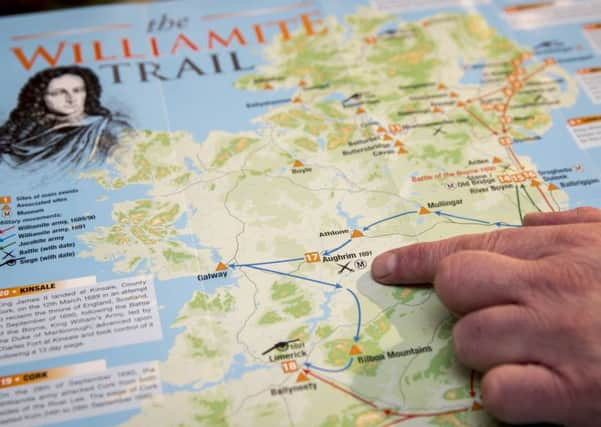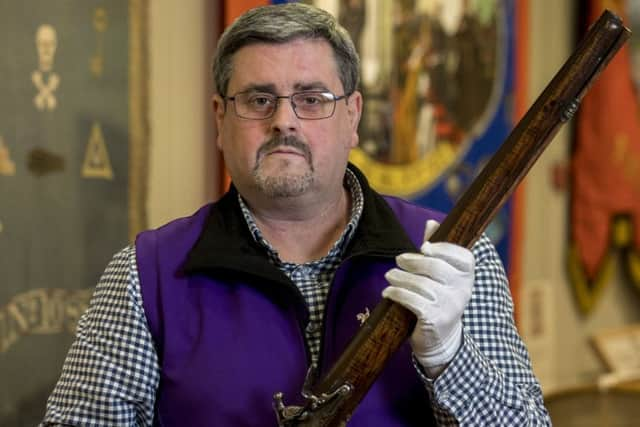Orange Order bid to put Williamite trail on tourist map


The Orange Order believes the small village of Aughrim in Co Galway can become a draw for visitors from across the island and beyond keen to learn about the bloodiest fight of the Williamite and Jacobite war.
The military engagement at Aughrim in 1691 was more intense than the famous Battle of the Boyne a year earlier, with 6,000 casualties compared to the 1,500 who fell at the Boyne.
Advertisement
Hide AdAdvertisement
Hide AdBut the presence of two kings on the Boyne battlefield - William of Orange and James II - ensured it was the encounter the history books have focused on.


The Grand Orange Lodge of Ireland now plans to spark renewed interest in Aughrim by making it a key stop on a Williamite tourist trail.
Senior members of the order are in talks with the Irish government and Tourism Ireland on the prospect of creating a signposted route that would allow people to follow the course of the war from the Siege of Derry in 1688 and William’s arrival at Carrickfergus in 1690 right down past the Boyne and across to Aughrim in the west.
The route would end in Limerick, where the Jacobite forces finally surrendered in 1691.
Advertisement
Hide AdAdvertisement
Hide AdDr Jonathan Mattison, curator of the Museum of Orange Heritage in Belfast, said aspects of the Williamite war had disappeared into the footnotes of history.
“The lesser known battle is that of Aughrim that was fought way out west in Galway and it is important that battles like that and events like that are remembered,” he said.
“Then of course another significant engagement took place in the city of Limerick which actually brought the war to an end.
“History is history and I think it’s important that everybody, no matter what their community and cultural background, examines history.
Advertisement
Hide AdAdvertisement
Hide Ad“I am a great exponent of Irish history and I think it’s key that aspects of this part of our 17th Century shared history are explored and exchanged backwards and forwards.
“What I would love to see is the physical infrastructure set in place. I would like to see markers and historical signs placed at the major points along the Williamite trail right from obviously Carrickfergus through to places like Limerick, so people and visitors can follow it.”
Explaining the historical significance, Dr Mattison said: “Aughrim is the bloodiest battle of the war, the last big field engagement.
“Both kings, James and William, have left Ireland by this stage and their commanders engaged in what they hope for the Jacobites is victory, so they can prolong the war, and for the Williamites they want that knock-out blow.
Advertisement
Hide AdAdvertisement
Hide Ad“So there are between five and six thousand casualties at Aughrim. It was a very close run battle and only for the fact that the (Jacobite) French commander of the day, St Ruth, is decapitated by a cannon ball, and the orders stop, the Williamites are eventually able to push through and win and the Jacobites then retreat to the stronghold of Limerick.”
Dr Mattison said the trail would allow lost “nuggets and diamonds” of history to be shared with a wider audience.
As an example, he recounted the story of a Co Down woman who chased after William’s army after his soldiers stole two of her horses.
“She actually followed the army protesting this and eventually was able to engage with William and he gave her horses back,” he said.
Advertisement
Hide AdAdvertisement
Hide Ad“He admired her pluckiness I think for following him down and protesting her case.”
Grand Secretary of the Grand Orange Lodge of Ireland, Rev Mervyn Gibson, said he was “realistic” about the trail’s potential.
“It’s not the Game of Thrones or Titanic Belfast, but it would be a major asset to the tourist offering,” he said.
Rev Gibson said the aim was to develop a “modern and fit-for-purpose” tourism trail.
Advertisement
Hide AdAdvertisement
Hide Ad“All our talks have been positive so far and encouraging,” he said.
“It’s a work in progress and we would hope to move it forward next year.
“There’s willingness on both sides to make this work because there’s benefit in it for the whole island.”